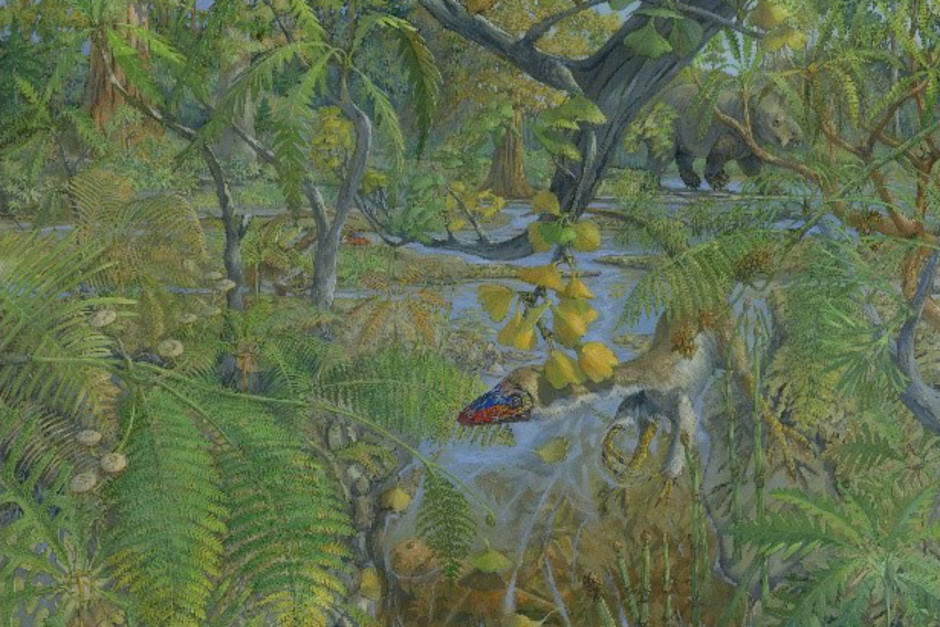Forskningsområden: Paleontologi
Forskningsämnen: Klimatförändringar, Växtevolution, Växtfysiologi
Project overview
Project period: 2021 - ongoing
Participating departments from the museum: Palaeobiology
Paleontologists from the Swedish Museum of Natural History and Molecular Plant Biologists from Lund University collaborate within this project uniting two different research fields. With funding from Knut and Alice Wallenberg Foundation, we carry out detailed analyses of fossilized plants (leaves and stems) and compare these to modern living relatives concerning microstructure, biomolecules and trace elements. Previously tested methods are combined with new techniques employing the recently installed Balder and NanoMax beamlines at MAX IV Swedish synchrotron facility in Lund. The aim is to provide unique insights into several extinct plant groups, their evolutionary relationships, physiology, and their adapted response to drastic environmental changes.
Project description
The realization that complex biomolecules can survive in the fossil record for millions of years is relatively new and revolutionary.
The Swedish Museum of Natural history impressive collections of fossil leaves and around 15000 specimens were collected from the coal measures and the sandstone spanning the Triassic-Jurassic boundary of Skåne, Sweden during the last hundred years. These fossils, together with other assemblages collected during various expeditions through the running time of the project, represent an archive of plant evolution through deep time and will form the base of the proposed project. Large-scale abundance studies of plants across major climatic events, together with detailed 3D analyses of Mesozoic plant parts such as cones and seeds provide important information concerning Mesozoic plants and their adapted response to drastic environmental changes.
The final aim is to gain knowledge on the physiological functions that govern plant resilience and survival during critical environmental conditions, and to allow modeling of gas exchange with the Mesozoic atmosphere. We further aim to bridge the impasse between genetic studies and morphological studies of fossils. Further, the long-term growth experiment of evolutionarily ancient and woody plants in an atmosphere with CO2 concentrations up to Jurassic conditions, will provide material useful for a large set of analyses.
Funding
Funding is acknowledged from Knut & Alice Wallenberg Foundation (KAW) grant ‘PlantEra’ 2020.0145
Selected publications
- Vajda, V., McLoughlin, S., Slater, S.M., Gustafsson, O., Rasmusson, A.G., 2023. The ‘seed-fern’ Lepidopteris mass-produced the abnormal pollen Ricciisporites during the end-Triassic biotic crisis. Palaeogeography, Palaeoclimatology, Palaeoecology 627.
- Cavalcante, L., Barbolini, N., Bacsik, Z., Vajda, V., 2023. Analysis of fossil plant cuticles using vibrational spectroscopy: A new preparation protocol. Review of Palaeobotany and Palynology
- Slater, S.M., Bown, P., Twitchett, R.J. Danise, S. & Vajda, V. 2022. Global record of “ghost” nannofossils reveals plankton resilience to high CO2 and warming. Science 376: 853-856. https://doi.org/10.1126/science.abm7330
 External link.
External link. - Vajda, V., Pucetaite, M. & Steinthorsdottir, M. 2021. Geochemical fingerprints of Ginkgoales across the Triassic-Jurassic boundary of Greenland. International Journal of Plant Sciences 182(7). https://doi.org/10.1086/715506
 External link.
External link. - Slodownik, M., Vajda, V. & Steinthorsdottir, M. (2021). Fossil seed fern Lepidopteris ottonis from Sweden records increasing CO2 concentration during the end-Triassic extinction event. Palaeogeography, Palaeoclimatology, Palaeoecology 564, 110157. https://doi.org/10.1016/j.palaeo.2020.110157
 External link.
External link. - Qu, Y., Yin, Z., Kustatscher, E., Nützel, A., Peckmann, J., Vajda, V., Ivarsson, M. 2023: Traces of Ancient Life in Oceanic Basalt Preserved as Iron-Mineralized Ultrastructures: Implications for Detecting Extraterrestrial Biosignatures. Astrobiology
Project members
Madison Tripp | Postdoctoral researcher

Susan Nehzati | Associated researcher
Project manager

Project member



